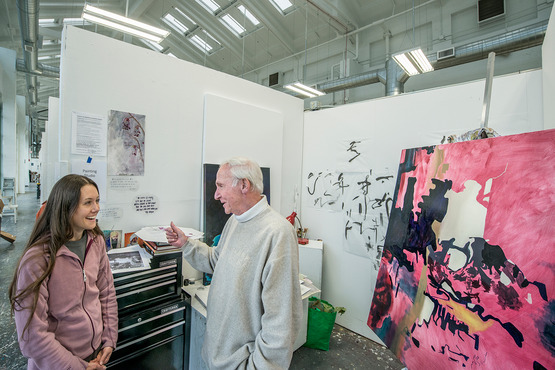
News . Feature Stories . Translating ideas and languages
News
March 24, 2014
Translating ideas and languages
Zimmerman brings Asian culture, communication to CIA students

By Carolyn Jack
River boat fire alone bright. For Cleveland Institute of Art students who work with Allen Zimmerman, it may be hard to tell where a poem stops and a painting begins. Since 1977, he has introduced his classes to the richly metaphorical languages and cultures of Asia, helping them see the connections between words and visual art.
Zimmerman’s skill in translating Chinese literature to English will be recognized this April, when Columbia University Press publishes his translation of the play “Scholar Chang Boils the Sea” – the tale of a poor scholar who challenges the Dragon King with Taoist magic and wins the heart of a wellborn woman – as part of the new volume, “The Columbia University Anthology of Yuan Drama,” edited by C. T. Hsia, Wai-yee Li, and George Kao.
But Zimmerman makes the greatest impression on student artists comes with his ability to translate ideas from one culture to another.
Take that string of words that Zimmerman offered as an example of poetic Chinese image-writing: “River boat fire alone bright.” Because the Chinese write using pictograph-like characters that symbolize ideas such as “home” rather than spoken sounds, sentences amount to idea clusters. Without any guiding grammatical connections such as prepositions, Zimmerman explained, the reader must interpret the relationships between the individual symbols.
“You’re jumping across little gaps,” he said. “So it’s an exercise in imagination.”
Just as in visual art.
Not surprisingly, his students like the idea of this kind of communication, Zimmerman noted: Because different people learn in different ways, some students find it easier to derive information from pictographs than from letter symbols. But, he added, however they prefer to read, they also respond as artists to aspects of Asian literature and culture such as calligraphy and gesture drawing, which capture vivid, nuanced meaning in a few sketched lines.
Zimmerman has been immersed in Asian cultures literally all of his life: Born and raised in Thailand, where his father worked for the YMCA International Committee, he attended high school in South India before coming to Ohio to study at Oberlin College. After a wartime stint in the Army Language School in California, Zimmerman was posted to Taiwan, where he spoke Chinese and read Japanese literature.
“Once you get into Chinese, you don’t get out of it,” he said with a gentle grin. “You just keep going.”
And he did, following his army years with post-graduate study in Columbia University’s Department of East-Asian Languages and, as a Fulbright Scholar, at Japan’s Kyoto University (“I convinced my professors that I could study Chinese language in Japan”), before returning to the U.S. to teach. When a friend left his position at CIA to go to New York, Zimmerman took the job, moving over from Case Western Reserve University to teach liberal arts and co-coordinate the Foundation Reinforcement Program. After decades as professor, dean of students and director of student counseling, he now teaches as a member of the adjunct faculty.
Zimmerman’s courses range from Creativity + Taoism, to Ways of Thought: Hinduism and Buddhism, and he teaches them to “expand the intellectual scope” of his students. Ask him why and he quotes his old friend and late CIA President Joseph McCullough: “ ‘Why have liberal arts at CIA? Because art is not created in a vacuum.’ ”
There’s something about Asian culture that artists seem to understand intuitively, Zimmerman concluded: It’s not a linear way of thinking. “They find,” he said, “a vocabulary that’s not available in English.”
Latest Headlines view all
-
April 23, 2024
Cleveland Institute of Art welcomes alum Omari Souza as 2024 Commencement speaker -
April 02, 2024
Cleveland Institute of Art students partner with Progressive Art Collection to exhibit Ready, Set, Relay! -
March 04, 2024
Cleveland Institute of Art announces Curlee Raven Holton Inclusion Scholar Program
Questions?
For more information about this or other CIA news, contact us here.
Social Feed